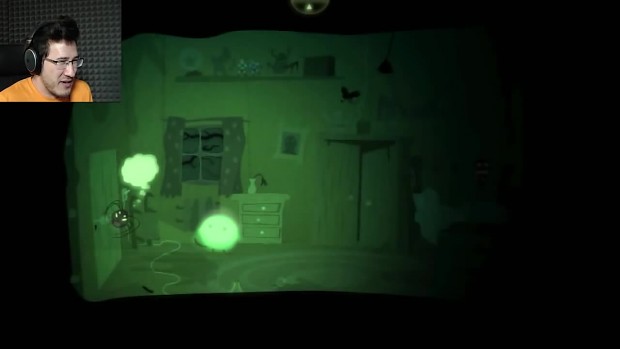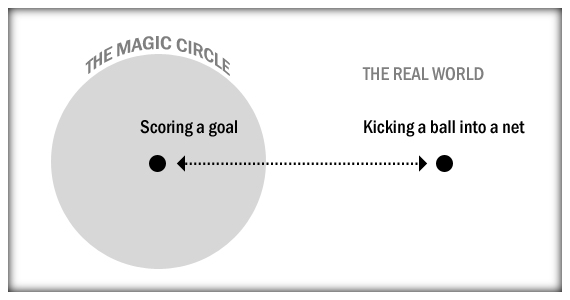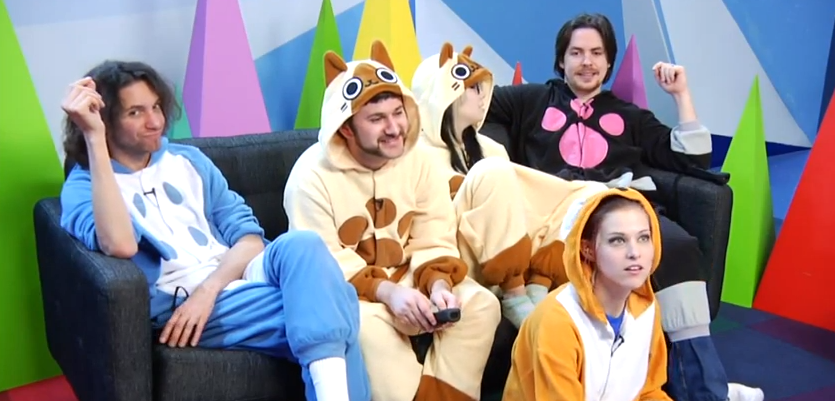Let’s Players. Screaming, flailing, analysing, crying internet-gamers. Since 2007, Let’s Players have been shouting their way through games for our amusement via first forums, then Youtube, and later Twitch. PewDiePie recently celebrated his 50,000,000 subscriber count (and incredible drama I’m not going into), so as usual, I think it’s time for me to take a look at the audience of Let’s Players.
What’s a Let’s Player?
A ‘Let’s Player’ is the term give to people who – either through videos, streaming, or screenshots (very rare) plays through a game for others. This can be with or without commentary…
May include a video feed of the gamer in the top corner…

Or may take to playing games…creatively.
They end up taking various forms. Some, like the Game Grumps, focus on comedy and more podcasts like feel. The emphasis is not placed solely on the game, but rather on the feel of sitting on a couch with friends as they game. Others have themes: Scary Game Squad choose to play horror games while drinking, an often fun mix. Speedrunners are dedicated to exploiting any and all game glitches to beat the game as fast as possible. Then there are channels like Birgirpall , who, like Speedrunners, are there to find glitches, but mostly just to giggle.
It’s hard to mention them all since there are as many different types of Let’s Players as there are games, but we’ll be looking into the ones that break the subscriber count. The ones with fandoms, the ones that seem to show up in the Youtube Rewind.
Fancy games design terms again?
So surprise surprise, if you’ve read my other work, I love to get right into the philosophy and games design of things. I mean that’s kind of my job, so you know – I’ll be giving you, my dear readers a small crash course in some terminology I use.
Encoding, Decoding.
Stuart Hall proposes the idea of Encoding; giving structure to something to be interpreted a particular way, and Decoding, the analysis of the structure through the audience. The idea is that 4 stages of media messages: production, circulation, consumption and reproduction, and talks about how these are all separate from each other.
In easier terms, if I wrote ‘I like trains!’, my encoded message may be that I just like trains, but through societal interpretation, you may decode it that I was referencing this. The production would be separate to the circulation and consumption because an editor may change it to ‘I like trains.’ – leading people to take it more seriously.
Magic Circle!

The Huizingas idea of the ‘Magic Circle’ was not specifically about video games, (because they weren’t invented yet) but rather about all forms of play. For there to be play, there must be rules, and if there are rules, there must be a state where the rules do not apply. So, the circle is where the rules of play do exist. Anything outside of that is not play, as it does not have the rules of the game.
If you don’t follow the rules of play in the circle, then you are either cast out, or the game changes to your rules, should you choose to dictate them. Those cast out are ‘outsiders’, or ‘spoilsports’. You see it all the time with children, especially playing tag. If you don’t adhere to the tag rules, you’re either out because you’re ruining it for others, or the game swiftly changes.
Response Cries
Conway discusses in ‘ARGH!: An Exploration of the Response Cries of Digital Game Players’ the theory that the type of guttural noises and reactions expressed by gamers, reflect particular subconsciously communicated meanings. Fear, anger, amusement, role distancing (the act of showing that you are not the role you are playing), all come across in nonverbal terms.
Parasocial Relationships
Parasocial relationships were first outlined by Horton and Wohl in regards to media and media consumers. It describes a relationship where one party is in a particular seat of fame, and the other is unknown to them, but still feels as if the famous one is a partner, friend or colleague.
It would be like – instead of saying that I am inspired by Hideo Kojima, a ‘normal’ view of a celebrity, I started claiming we were friends because he tweets relatable things. He’s not my friend, he doesn’t know who I am. (Though if you’re reading this Kojima, I’ve got some great ideas for Death Stranding, call me. Please.)
Back to Let’s Players, Please
Right! Sorry. So with PewDiePie breaking 50,000,000, something’s gotta give. The majority of people on the internet love to criticise Pewds, but clearly, he’s doing something right. And what that is, along with Markiplier, JackSepticEye, Cryaotic , Game Grumps; and countless others, is that they have stumbled on a formula that imperially works.
The most popular of YouTubers imperially appeal to the exact opposite of what is supposedly encoded in them. Instead of appealing to the ‘magic circle’ of gamers, they appeal to the outsiders, creating a new different circle for them. Let’s Players are not for the normal gaming audience, they are not there for the teenage, cis-gendered, heterosexual, white male, they are there for those who exist outside of that.
Now don’t lynch me for that. I’m not saying that these men can’t also watch Let’s Players (and they do), I’m just saying Let’s Players’ primary success doesn’t come from that group.
The Calling
Encoded.
Let’s Players use terminology and language implying encoded mainstream ‘gamer’ ideology in the way they speak. The call goes out to people like them, supposedly. This is not necessarily how it comes across, though.
The top ten most subscribed gaming Youtubers are male. With this in mind, it is a widely recognised fact that ‘gamers’ are straight, white dudes. So honestly, it’s not surprising that a lot of them talk of ‘manly things’. Male coded, gendered language, sometimes toxic masculinity tropes come across in videos constantly.
Such as how ‘strong and handsome’ they are, while others make jokes about being gay. Pewds was known in his earlier career to make gay jokes, rape jokes and another crude kind of things we associate with gamer culture: he has since made an apology video. (Character growth!) (Edit: Oh how wrong I was.)
On initial viewing of these guys, they appear to be presenting an experience and media that should only speak to others like them – white, male, cis-gendered and heterosexual (mostly, I sincerely doubt that every popular Let’s Player is all of those).
Decoded.
However, the fanbases seem to be consistently decoded the experience differently. Personally, and after spending a lot of time on Reddit and Tumblr for Let’s Players fandoms, it comes across a lot more like the feeling of a personally talking to you on the subject of gaming, rather than a display of gaming intellect. This means that the kind of people this appeals to tends to be the people existing outside of the ‘gamer’ circle, creating a soft, gentle space for the ‘others’. It’s an open communication of an almost-parody of the traditional ideas of who this should appeal to. But if it were meant for the ‘traditional gamer’, then why would they ‘lower’ themselves to watching instead of playing?
It seems the more popular these people get, the more of a ‘faggot’ or ‘girly’ or ‘retarded’ they are within mainstream gamer communities, however. Unsure if that’s correlated to just them learning how to appeal to their particular audience, or people just hating the ‘spoilsports’ for existing and getting enjoyment out of a game in the ‘wrong’ way.
The SCREAMING.
Response cries overall come out of one of two kinds of gamers. The veteran gamers, who are quiet and focused, or the beginner/casual gamers, who are more enthusiastic and ready to perform a role.
You can probably guess where this is going, but Let’s Players really like to act like beginners. Common cries of ‘what was that?!’ and hamming it up is throughout so many popular channels. Again, this is a direct call to people who maybe aren’t the most Veteran/‘Serious’ of gamers. Not only that, it’s fun!
Since most have found their fame playing horror games, we look to ‘threat startles’. While mostly viewed for people unable/unwilling to play the horror games themselves, there is a wonderful sense of schadenfreude from watching someone get really startled. The threat startle, or the little ‘Ahh!’ ‘Eeek!’(that are perceived as ‘feminine’ but I won’t get into that today) that come from playing horror games really act as a binder to group people together and giggling at each other’s fright. Spooky Games Squad is entirely built on that.
Get together a group of people, and have one play a horror game. Watch how everyone groups together and cheers each other on, screaming along and jumping and hiding their eyes. I used to play Amnesia with 4 of my friends grouped behind me, their yells scaring me more than the game. Let’s Players have tapped into this; with the exception that there’s an extra layer of screen between you and then. Speaking of that screen, though…
The Parasocial
‘Cause the screen is very much still there. Parasocial relationships are more likely when someone has social anxiety or shyness issues: which is most gamers, especially those who don’t feel comfortable in their own community.
Now take that and give people a platform to have gaming conversations, hangouts, even deep and meaningful (albeit, one-sided) conversations, and to practice and observe safe social relationships – all from their computer. Is it any wonder the Let’s players who post their whole lives all over the internet; Twitter, Snapchat, Facebook, Instagram, Youtube (obviously) and various others, get a large following of parasocial relationships?
It’s both a blessing and a curse. More followers, but more possessive followers. Constant harassment that comes with fame is something no one would enjoy, and while celebrity internet fame is still seen as ‘lesser’, it does mean tailor-made fans, and tailor-made stalkers.
It does also allow a different side to be seen. Most Let’s Players openly invite people into their life, with little nicknames and roles for their fans. The sharing of personal information makes it feel like a ‘real’ friendship: you know stuff about them that your friends know about you! That’s how it works, right? As well as in ‘vlogs’, they get to see men being emotional and intimate – expressing their feelings is something seen as very personal and close in today’s society for bullshit reasons.
It’s obviously not a perfect model. Parasocial relationships are not seen as healthy, and are often shamed. But as a business model, it’s brilliant. Pewds has a book (which hit number one on new york times best seller list) and a game, both incredibly successful due to his fanbase.
The Others
So, when I talk about the ‘outcasts’, the ones outside the magic circle, who am I talking about?
Well, who are the people who are instantly cast out of voice chat in MMPORGs? Who aren’t allowed in the gaming circles without an extensive quiz of their knowledge? Shunned from games stores and laughed out of competitions?
You know the kind – anyone not a straight, white, cis, younger male. Why can’t anyone type that sentence on the internet these days without everyone cringing? It’s a statement of gaming statistic facts! Or – what people thought they were.
These boys rule the roost of the games world. Everyone else is the outsider.
Youtubers tap into that. They fit the criteria of a ‘Gamer’ (heavy air quotes). They turn to the outsiders and they are kind. Is it any wonder they shoot to stardom so fast after that?
Some final points:
Let’s be real. The popular Let’s Players get a lot of flack. There’s a lot of reasons for it, but the ones that stand out for me, tend to just be rooted in gamer culture. They’re seen as bad at games because they act silly and are relatable. They appeal to women, which is always a huge no-no in games. (Times they are a-changing!) They’re often over the top, or seen as hysterical.
These aren’t at all bad things. It’s just they only appeal to a certain audience. But – it is interesting how many people DO find this appealing. Maybe it’s rooted in gamer culture, maybe it’s rooted in misogeny, maybe Let’s Players are just really clever at business.
Either way, here’s my favourite Let’s Play series! (Content warning: disturbing themes, violence and sexual imagery)
And of course don’t forget to like, comment, and subscribe!

